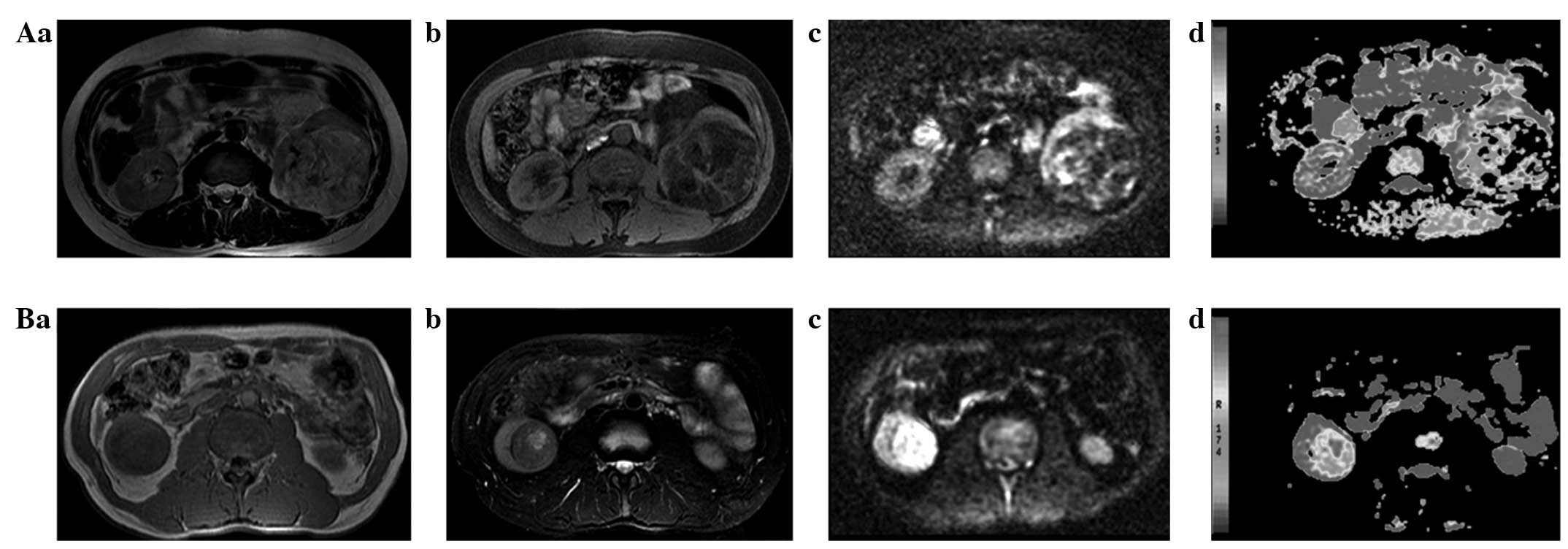|
1
|
Lam JS, Shvarts O and Pantuck AJ: Changing
concepts in the surgical management of renal cell carcinoma. Eur
Urol. 45:692–705. 2004. View Article : Google Scholar : PubMed/NCBI
|
|
2
|
Kirkali Z and Öber C: Clinical aspects of
renal cell carcinoma. EAU Update Series. 1:189–196. 2003.
View Article : Google Scholar
|
|
3
|
Fujii Y, Komai Y, Saito K, Iimura Y,
Yonese J, Kawakami S, Ishikawa Y, Kumagai J, Kihara K and Fukui I:
Incidence of benign pathologic lesions at partial nephrectomy for
presumed RCC renal masses: Japanese dual-center experience with 176
consecutive patients. Urology. 72:598–602. 2008. View Article : Google Scholar : PubMed/NCBI
|
|
4
|
Jeon HG, Lee SR, Kim KH, Oh YT, Cho NH,
Rha KH, Yang SC and Han WK: Benign lesions after partial
nephrectomy for presumed renal cell carcinoma in masses 4 cm or
less: Prevalence and predictors in Korean patients. Urology.
76:574–579. 2010. View Article : Google Scholar : PubMed/NCBI
|
|
5
|
Xiong YH, Zhang ZL, Li YH, Liu ZW, Hou GL,
Liu Q, Yun JP, Zhang XQ and Zhou FJ: Benign pathological findings
in 303 Chinese patients undergoing surgery for presumed localized
renal cell carcinoma. Int J Urol. 17:517–521. 2010. View Article : Google Scholar : PubMed/NCBI
|
|
6
|
Loh S, Bagheri S, Katzberg RW, Fung MA and
Li CS: Delayed adverse reaction to contrast-enhanced CT: A
prospective single-center study comparison to control group without
enhancement. Radiology. 255:764–771. 2010. View Article : Google Scholar : PubMed/NCBI
|
|
7
|
Katzberg RW and Newhouse JH: Intravenous
contrast medium-induced nephrotoxicity: Is the medical risk really
as great as we have come to believe? Radiology. 256:21–28. 2010.
View Article : Google Scholar : PubMed/NCBI
|
|
8
|
Marckmann P, Skov L, Rossen K, Dupont A,
Damholt MB, Heaf JG and Thomsen HS: Nephrogenic systemic fibrosis:
Suspected causative role of gadodiamide used for contrast-enhanced
magnetic resonance imaging. J Am Soc Nephrol. 17:2359–2362. 2006.
View Article : Google Scholar : PubMed/NCBI
|
|
9
|
Deo A, Fogel M and Cowper SE: Nephrogenic
systemic fibrosis: A population study examining the relationship of
disease development to gadolinium exposure. Clin J Am Soc Nephrol.
2:264–267. 2007. View Article : Google Scholar : PubMed/NCBI
|
|
10
|
AbuAlfa AK: Nephrogenic systemic fibrosis
and gadolinium-based contrast agents. Adv Chronic Kidney Dis.
18:188–198. 2011. View Article : Google Scholar : PubMed/NCBI
|
|
11
|
Artz NS, Sadowski EA, Wentland AL, Grist
TM, Seo S, Djamali A and Fain SB: Arterial spin labeling MRI for
assessment of perfusion in native and transplanted kidneys. Magn
Reson Imaging. 29:74–82. 2011. View Article : Google Scholar : PubMed/NCBI
|
|
12
|
Irie H, Kamochi N, Nojiri J, Egashira Y,
Sasaguri K and Kudo S: High b-value diffusionweighted MRI in
differentiation between benign and malignant polypoid gallbladder
lesions. Acta Radiol. 15:236–240. 2011. View Article : Google Scholar
|
|
13
|
Chandarana H, Lee VS, Hecht E, Taouli B
and Sigmund EE: Comparison of biexponential and monoexponential
model of diffusion weighted imaging in evaluation of renal lesions:
Preliminary experience. Invest Radiol. 46:285–291. 2011.PubMed/NCBI
|
|
14
|
Rheinheimer S, Stieltjes B, Schneider F,
Simon D, Pahernik S, Kauczor HU and Hallscheidt P: Investigation of
renal lesions by diffusion-weighted magnetic resonance imaging
applying intravoxel incoherent motion-derived parameters-initial
experience. Eur J Radiol. 81:e310–e316. 2012. View Article : Google Scholar : PubMed/NCBI
|
|
15
|
Sandrasegaran K, Sundaram CP, Ramaswamy R,
Akisik FM, Rydberg MP, Lin C and Aisen AM: Usefulness of
diffusion-weighted imaging in the evaluation of renal masses. AJR
Am J Roentgenol. 194:438–445. 2010. View Article : Google Scholar : PubMed/NCBI
|
|
16
|
Baliyan V, Das CJ, Sharma S and Gupta AK:
Diffusion-weighted imaging in urinary tract lesions. Clin Radiol.
69:773–782. 2014. View Article : Google Scholar : PubMed/NCBI
|
|
17
|
Chen S, Ikawa F, Kurisu K, Arita K, Takaba
J and Kanou Y: Quantitative MR evaluation of intracranial
epidermoid tumors by fast fluid-attenuated inversion recovery
imaging and echo-plannar diffusion-weighted imaging. AJNR Am J
Neuroradiol. 22:1089–1096. 2001.PubMed/NCBI
|
|
18
|
Doğanay S, Kocakoç E, Ciçekçi M, Ağlamiş
S, Akpolat N and Orhan I: Ability and utility of diffusion-weighted
MRI with different b values in the evaluation of benign and
malignant renal lesions. Clin Radiol. 66:420–425. 2011. View Article : Google Scholar : PubMed/NCBI
|
|
19
|
Mytsyk Y, Borys Y, Komnatska I, Dutka I
and Shatynska-Mytsyk I: Value of the diffusion-weighted MRI in the
differential diagnostics of malignant and benign kidney
neoplasms-our clinical experience. Pol J Radiol. 79:290–295. 2014.
View Article : Google Scholar : PubMed/NCBI
|
|
20
|
Zhang YL, Yu BL, Ren J, Qu K, Wang K,
Qiang YQ, Li CX and Sun XW: EADC values in diagnosis of renal
lesions by 3.0 T diffusion-weighted magnetic resonance imaging:
Compared with the ADC values. Appl Magn Reson. 44:349–363. 2013.
View Article : Google Scholar : PubMed/NCBI
|
|
21
|
Zimmerman RD: Is there a role for
diffusion-weighted imaging in patients with brain tumors or is the
‘bloom off the rose’? AJNR Am J Neuroradiol. 22:1013–1014.
2001.PubMed/NCBI
|
|
22
|
Wang J, Takashima S, Takayama F, Kawakami
S, Saito A, Matsushita T, Momose M and Ishiyama T: Head and neck
lesions: Characterization with diffusion-weighted echo-planar MR
imaging. Radiology. 220:621–630. 2001. View Article : Google Scholar : PubMed/NCBI
|
|
23
|
Huisman TA: Diffusion-weighted imaging:
Basic concepts and applicationin cerebral stroke and head trauma.
Eur Radiol. 13:2283–2297. 2003. View Article : Google Scholar : PubMed/NCBI
|











